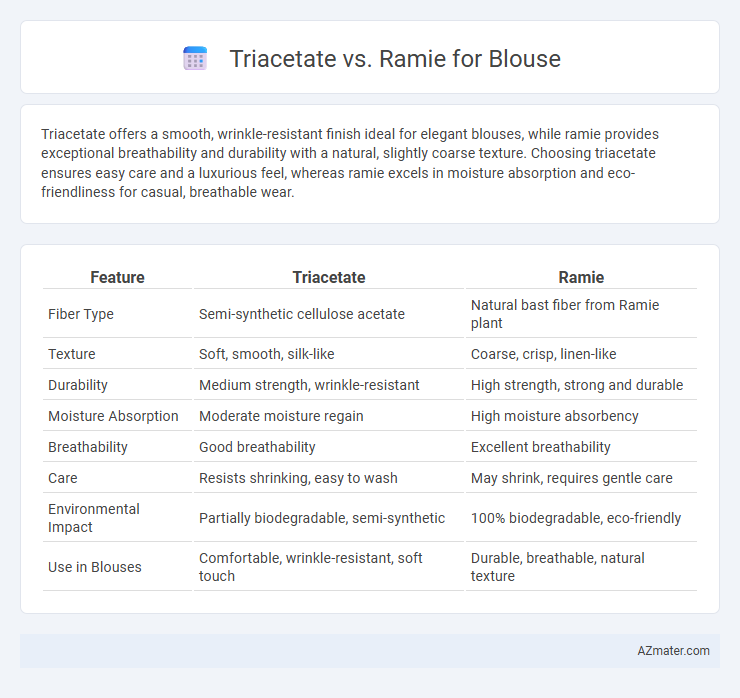Triacetate offers a smooth, wrinkle-resistant finish ideal for elegant blouses, while ramie provides exceptional breathability and durability with a natural, slightly coarse texture. Choosing triacetate ensures easy care and a luxurious feel, whereas ramie excels in moisture absorption and eco-friendliness for casual, breathable wear.
Table of Comparison
| Feature | Triacetate | Ramie |
|---|---|---|
| Fiber Type | Semi-synthetic cellulose acetate | Natural bast fiber from Ramie plant |
| Texture | Soft, smooth, silk-like | Coarse, crisp, linen-like |
| Durability | Medium strength, wrinkle-resistant | High strength, strong and durable |
| Moisture Absorption | Moderate moisture regain | High moisture absorbency |
| Breathability | Good breathability | Excellent breathability |
| Care | Resists shrinking, easy to wash | May shrink, requires gentle care |
| Environmental Impact | Partially biodegradable, semi-synthetic | 100% biodegradable, eco-friendly |
| Use in Blouses | Comfortable, wrinkle-resistant, soft touch | Durable, breathable, natural texture |
Introduction to Triacetate and Ramie Fabrics
Triacetate fabric is a synthetic fiber derived from cellulose, known for its wrinkle resistance, smooth texture, and durability, making it ideal for blouses that require low maintenance and a polished appearance. Ramie, a natural bast fiber extracted from the stalks of the Boehmeria plant, offers breathability, moisture-wicking properties, and a slightly textured feel, favored for lightweight, comfortable blouses suitable for warm climates. Understanding these characteristics helps in selecting between Triacetate's easy-care performance and Ramie's natural, eco-friendly advantages for blouse fabric choices.
Overview of Triacetate: Properties and Advantages
Triacetate is a semi-synthetic fiber derived from cellulose, known for its exceptional wrinkle resistance, dimensional stability, and resistance to shrinkage, making it ideal for blouses that require low maintenance. Its smooth, silky texture offers a luxurious feel while being breathable and moisture-wicking, enhancing wearer comfort in various climates. The fiber's durability and resistance to fading contribute to long-lasting vibrant colors and garment shape, distinguishing triacetate as a practical yet elegant choice compared to natural fibers like ramie.
Understanding Ramie: Characteristics and Benefits
Ramie is a natural fiber derived from the stalks of the Chinese nettle plant, known for its exceptional durability and breathability, making it an excellent choice for blouse fabrics. Its moisture-wicking properties and resistance to wrinkles provide comfort and ease of care compared to synthetic alternatives like triacetate. Ramie also offers a silky texture and a lustrous sheen, enhancing the aesthetic appeal of blouses while maintaining biodegradability and eco-friendliness.
Comfort and Breathability Comparison
Triacetate fabric offers a smooth, wrinkle-resistant texture with moderate breathability, making it comfortable for short-term wear but sometimes less effective at moisture wicking. Ramie, a natural fiber, excels in breathability and moisture absorption, promoting superior comfort during hot or humid conditions by allowing better air circulation. When prioritizing comfort and airflow for blouses, ramie's natural properties typically outperform triacetate's synthetic blend, especially in warm climates.
Durability and Longevity: Triacetate vs Ramie
Triacetate offers moderate durability with resistance to wrinkles and shrinkage, making it suitable for blouses that require low maintenance and a longer lifespan under everyday wear. Ramie, a natural fiber known for its high tensile strength and breathability, provides superior durability and can withstand frequent washing while maintaining fabric integrity over time. When comparing longevity, Ramie outperforms Triacetate due to its resilience, moisture absorption, and ability to retain color and texture after repeated use.
Care and Maintenance: Which Is Easier?
Triacetate blouses offer easier care due to their wrinkle resistance and ability to withstand regular machine washing without damage, reducing the need for frequent ironing and dry cleaning. Ramie blouses require more delicate maintenance, often needing gentle hand washing and careful drying to avoid shrinkage and fabric stiffening. Choosing triacetate simplifies everyday wear and long-term upkeep compared to the high-maintenance care demanded by ramie.
Aesthetic Qualities: Texture, Drape, and Color Retention
Triacetate offers a smooth, silky texture with excellent drape, creating elegant, flowing blouses that maintain their shape over time. Ramie showcases a coarse yet breathable texture, producing blouses with a natural, textured appearance and moderate drape suitable for casual styles. Triacetate excels in color retention due to its synthetic fibers, ensuring vibrant hues after multiple washes, whereas ramie tends to fade more quickly, requiring gentle care to preserve color intensity.
Sustainability and Environmental Impact
Triacetate fabric, derived from cellulose acetate fibers, offers biodegradability and lower chemical use during production, making it a more sustainable choice compared to synthetic materials. Ramie, a natural bast fiber obtained from the stalks of the Ramie plant, boasts excellent biodegradability, requires minimal pesticides, and has a lower water footprint, enhancing its environmental benefits for blouse production. Both materials support eco-friendly fashion, but Ramie's lower resource consumption and natural fiber composition position it as a highly sustainable option.
Cost and Availability in the Market
Triacetate fabric for blouses tends to be more cost-effective due to its synthetic production process and widespread availability in the market, making it a budget-friendly choice for manufacturers and consumers. Ramie, a natural fiber derived from the stalks of the Chinese grass plant, generally commands a higher price because of its labor-intensive harvesting and limited global supply. While triacetate is readily accessible in various retail and wholesale outlets, ramie's niche market status often means it is less commonly stocked and may require sourcing from specialty suppliers.
Choosing the Best Fabric for Your Blouse
Triacetate offers wrinkle resistance, smooth texture, and excellent color retention, making it ideal for blouses that require durability and easy care. Ramie, a natural fiber derived from the nettle plant, provides breathability, moisture-wicking properties, and a luxurious sheen, perfect for lightweight, breathable blouses in warm climates. Choosing between triacetate and ramie depends on prioritizing synthetic durability and wrinkle-free convenience versus natural breathability and eco-friendliness.

Infographic: Triacetate vs Ramie for Blouse
 azmater.com
azmater.com